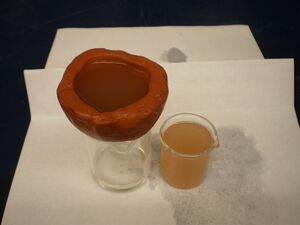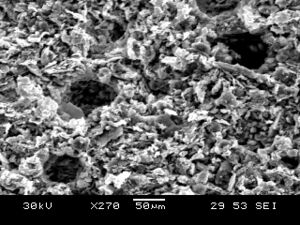
Ceramic water filters, pot filters, ceramic water purifiers or ceramic silver water filters are ceramics pots made from a mixture of clay and sawdust fired at a relatively low temperature.
The most well known example of their use for filtering water in the developing world comes from Potters for Peace, who have a process for mass producing such filters, which are also impregnated with silver to kill off harmful bacteria and viruses. Such mass produced filters are certainly not the only instance or possible way of obtaining ceramic clay filters, as the resources needed, clay, sawdust, and water, are available in most parts of the world, and the manufacturing process is relatively simple.
Summary[edit | edit source]
An earthenware clay is mixed with an organic burnout material of proper particle size. The material is then formed into the shape of a pot and fired. In the process of firing the organic material burns away leaving micro-pores in the fired clay body. After firing, the filters are often treated with colloidal silver or silver nitrate to prevent bacterial or plant growth inside the pot.
Contaminated water is put into the pot, and as it passes through the small pores bacteria and particles are removed. These filters have commonly acchieved a 98% success rate in removing coliform bacteria (I have some studies to post later). The pot filters are usually made to fit into a receptacle such as a 5 gallon bucket to capture the filtered water.
Reasons for Use[edit | edit source]
Lack of access to clean water is one of the leading problems facing the world today, affecting over one billion people.[1] Past attempts by the developed world to create centralized water purification and distribution systems in the developing world have been met with failure. This leads to a need for Point-Of-Use household water filtration as a transition technology at least, and possibly even a sustainable solution.
This availability of materials and relative ease of production makes ceramic clay filters ideal as an appropriate technology to fill this need in many communities. Instead of relying on outside organizations to provide outside solutions, communities can create filters using materials and techniques that are likely already used.[2] This decreases reliance on charity, provides opportunities for local artisans to earn money, and generally leads to a sustainable method for water purification.
This is not an appropriate solution for all areas however. If resources like clay or fuel for firing are absent or hard to obtain, or if better options exist, ceramic clay filters may not work. In addition, ceramic filters can usually filter out sediment and particles, and occasionally bacteria, but without silver impregnation they cannot filter out viruses or some small bacteria. In this case, other purification methods like boiling or chlorine disinfecting additives like "water guard" must also be used.
How it's Made[edit | edit source]
The Potters for Peace organization has a relatively standard process for creating their filters, described here: http://web.archive.org/web/20110627081553/http://pottersforpeace.org:80/wp-content/uploads/production-manual-iraq.pdf.
Their recipe involves a 50/50 mix of clay and sawdust by volume, this ratio can vary significantly depending on clay body and burnout materials used. The current standard assumes filters which flow at a rate of 1.5 to 3 litres per hour are effectively removing bacteria. Current studies are questioning the relationship between flow-rate and bacteria removal effectivity. The desire is to develop a filter with a greater rate of flow while maintaining effectivity.
The dry clay and sawdust are mixed thoroughly. Then water is added as mixing is continued until the entire mixture can clump together. The clay is then be wedged thoroughly and formed into the filter shape through the use of molds and a press.
The initial firing schedule involves increasing temperature 75 degrees Celsius per hour until 350degC to allow all of the pore water, the water from moisture in the air trapped in small holes in the clay, to escape without damaging the pots.
After this the pots can be brought up to the firing temperature of 900 degrees Celsius (cone 010) at a rate of 100degC per hour. They should then be held at this temperature for 1 hour, then allowed to cool naturally.
The exact ratios of clay and burnout material, and kiln firing schedules vary significantly depending on variables in clay body and burnout material.
The latest document detailing the manufacturing process is the 2011 Best Practices Manual for Ceramic Water Filter Production: http://potterswithoutborders.com/2012/10/best-practice-recommendations-for-local-manufacturing-of-ceramic-pot-filters-for-household-water-treatment/
How it Works[edit | edit source]

Ceramic clay filters work in a couple of ways, their exact function is not completely understood. The filters work mechanically by filtering water through tiny pores small enough to stop many contaminants like clay, dirt, and possibly even bacteria. These pores are formed partially by the sawdust burning off during the firing process, and partially by the pores that form naturally in the clay due to the low firing temperature.
Most pathogens are attached to particles in the water, so removing these particles makes the water much safer to drink.
Secondly, filters are treated with a silver solution (Colloidal Silver or Silver Nitrate). Bacteria is destroyed when it comes in contact with silver particles. The interconnected pores withing the filter body create a tortuous path which increases the chance of bacteria to come in contact with the silver particles.
The silver also acts to prevent bacterial re-growth within the filter walls where it becomes trapped.
There is a lot of discussion about which method of silver application is most effective. The majority of factories currently paint on or dip colloidal silver, others are mixing silver nitrate directly into the filter mix. Problematic factors with the use of silver products include its high cost, and methods of disposal.
Clay pores alone would make an extremely slow filter, while a filter with too much sawdust would be ineffective and easily crushed. Beginning with a mixture of 50/50 by volume and a firing temperature of 900 degrees can create an effective balance between flow rate, effectiveness, and durability.
Dung fired clay pot filters[edit | edit source]
- Note: more up-to-date information is needed for this section. The following information dates from approximately 2005.
An Australian materials scientist and potter, Tony Flynn, developed a very similar process for a World Vision project in Manatuto, East Timor, but using open dung fires. He describes the difficulty of accessing suitable kilns in rural East Timor. However he later saw a dung fire with a color that he recognized from his experience as a potter - the color indicating a temperature in the range needed for firing the simple hand-formed clay pots. He then confirmed through experiments that firing the pots on an open dung fire did create an effective water filter.
The initial filtrate (output water) is slightly cloudy, from residue from the firing. After a few times being used, the water should become clearer.
A proposed use is to create a series of three water filters, each feeding water to the next, so that the final output is much more pure.
This could be considered an intermediate technology, as the resulting water is not as pure as using a filter made in a more exacting process; however it is much better than is generally achieved achievable at the village-level, and potentially more achievable than mass-produced filters.
Field use[edit | edit source]
- Used in Cambodia by Resource Development International – Cambodia.
- East Timor, as described above in #Dung fired clay pot filters.
Notes and references[edit | edit source]
[1] http://www.healtheconomics.org/books/2003/01/01/making-choices-in-health-.html https://ar.pureaqua.com/cartridge-filter-housings-industrial-commercial/